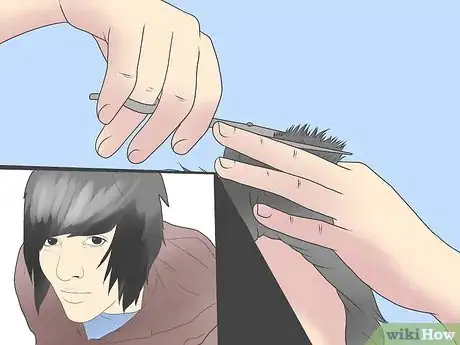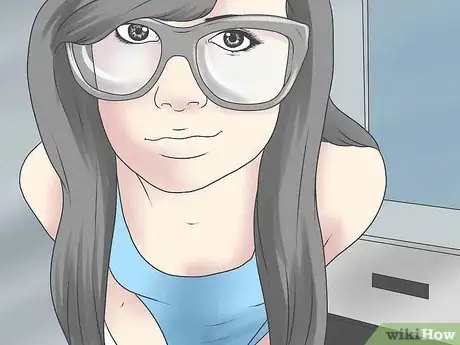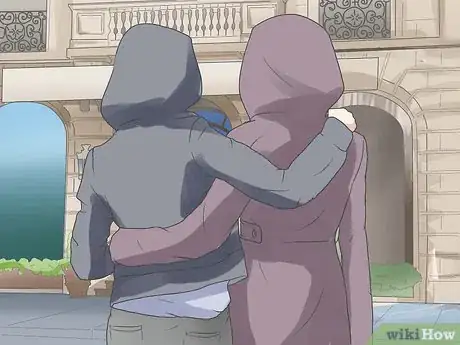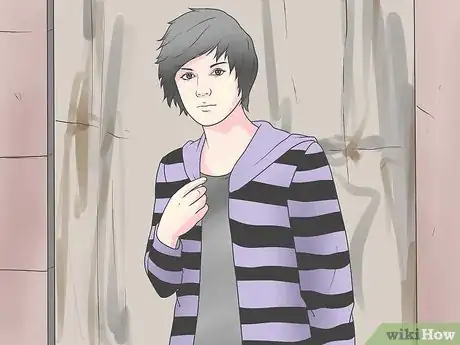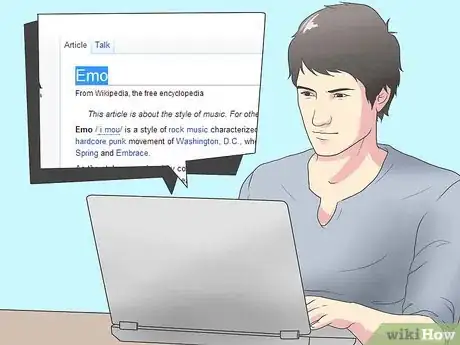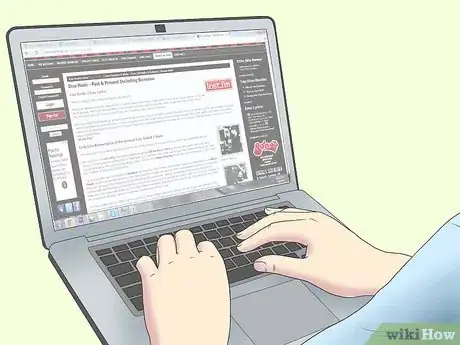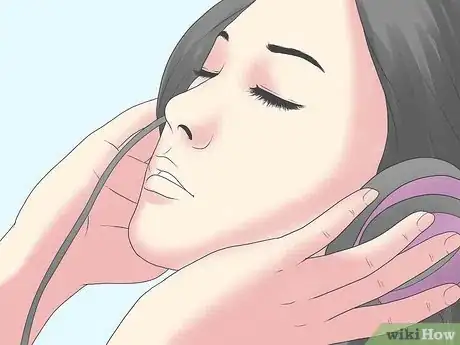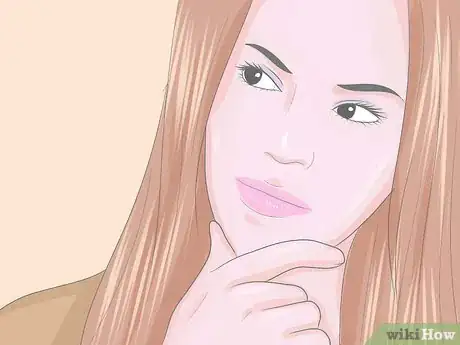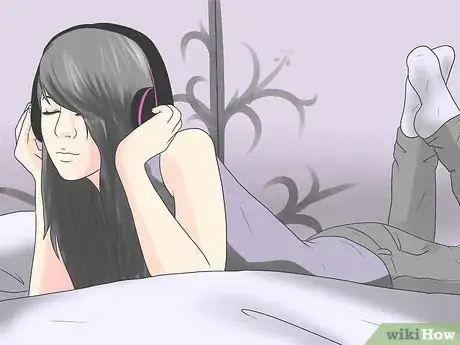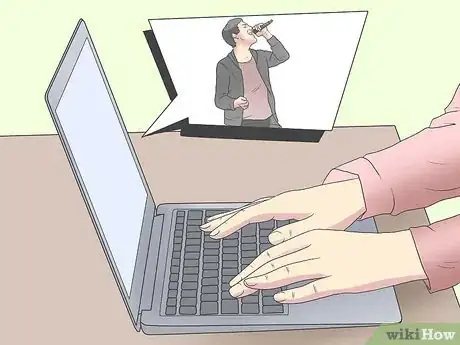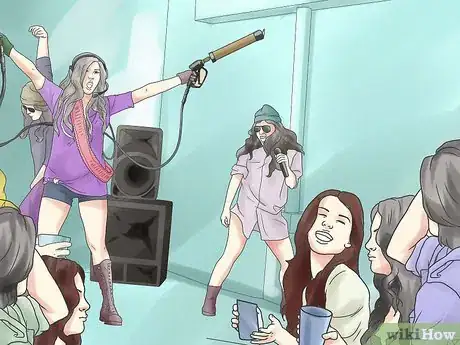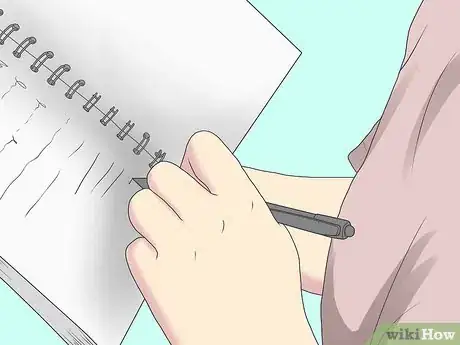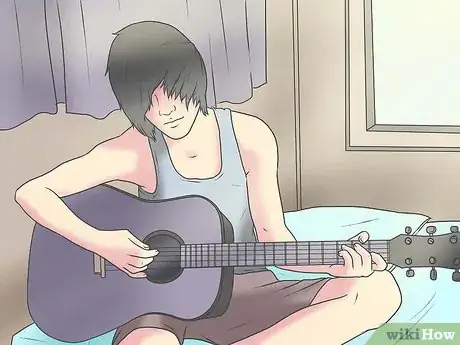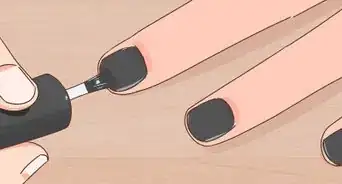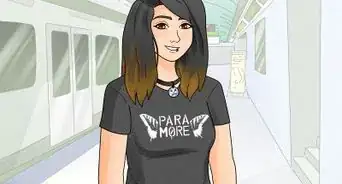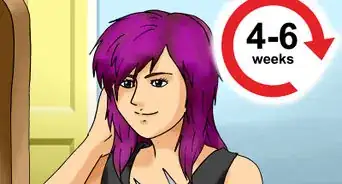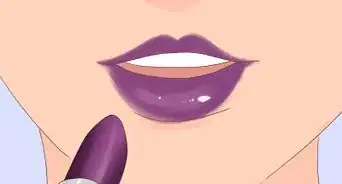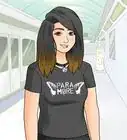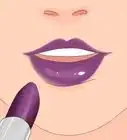This article was co-authored by Regina Dunn. Regina has been passionate about the goth subculture for over 10 years. She studied goth fashion and subculture in school and she has worked to fight misinformation and misappropriation about the goth subculture within the media. Regina is active in a range of online communities and wikis, continuing to educate and get exposure for goth music and subculture.
There are 21 references cited in this article, which can be found at the bottom of the page.
This article has been viewed 2,802,236 times.
From the suburbs to the beaches, from Mexico to Iraq, teenagers have been self-identifying as "emo" for years, yet it still manages to confound and confuse the mainstream today. What is emo and what does it even mean to be emo? Based on the melodically-aggressive and complicated underground music of mid-80s Washington DC, emo has its roots in mostly hardcore punk and indie but it has expanded into many styles, sounds, and cultures from indie rock to pop-punk. Emo is huge and it's here to stay. If you want to learn about the history, the music, and the culture to get started participating in emo culture, you've come to the right place.
Things You Should Know
- Update your hairstyle and makeup to adopt a classic Emo look.
- Embrace Emo fashion with vintage t-shirts and checked shirts, thick horn-rimmed glasses, messenger bags, and canvas slip-on shoes.
- Add some Emo bands and Emo subgenres to your playlist.
- Participate in Emo culture to really feel like a part of the Emo community.
Steps
Looking the Part
-
1Get an Emo appearance. Start with getting emo styled hair; up until the mid-2000s, there was no real emo hairstyle. These days, "emo hair" usually refers to a particular layered haircut in which long bangs are swept and styled to one side usually held in place with mousse, hair gel, or pomade. The color is mainly their original but sometimes, emo hair is dyed black and sometimes features a bright highlight of blonde or other punky colors.
- To get modern-day emo hair, start growing out your bangs but still getting clean-up cuts on the back of your neck. Pull the bangs over evenly across above your eyebrow and use mousse, hair gel, or pomade. If you're female, get layers in your hair on the sides.
- To get modern styled makeup, start using liquid or pencil eyeliner. Don't be afraid to apply to the waterline, experimenting with this will only make you better.
- Start wearing nail polish, black is usually a popular color among emos. Don't be afraid to wear different colors or mix them, either.
- Consider getting piercings. Snake bites and septum rings are very common piercings among the emo community; if you are old enough, contemplate getting one of your fancies.
-
2Dress in Emo fashion. Start changing your wardrobe to include more garments involved with the emo subculture. In the beginning, there was no real emo fashion, but as it moved towards the mainstream, that's when skinny jeans and eyeliner started to become popular. Start investing in:
- Plaid shirts and sweaters are popular in Midwestern emo fashion.[1]
- Vintage t-shirts and checked shirts: checked shirts match well with band t-shirts, especially if they are in black and white print. Wear emo bands t-shirts as Rites of Spring, Moss Icon, Sunny Day Real Estate, Armor For Sleep or American Football underneath.
- Thick horn-rimmed glasses, these are optional but they were worn in the original emocore style.[2]
- Messenger bags to carry your notebooks and diary around; you never know when you may get a hit of inspiration. Emo is about being creative so don't hesitate to carry around a sketchbook or pencils in there, either.
- Flat shoes such as converse or vans: any type of canvas slip-on shoes work well, too, and you can buy these from any budget shoe store. You do not have to buy them new.[3]
- Accessories: keep an eye out for scarves, bandanas, stripy socks, wristbands/sweatbands, studded belts, safety pins/badges, and fingerless gloves. Stay away from anything fishnet/anything sporting dark patterns, or anything that looks even remotely like a razor-blade, emo is not dark, and by wearing something that looks like a razor-blade, you are only perpetuating unfair stereotypes.
-
Skinny jeans: buy several pairs of black, blue, and even multi-colored skinny jeans; you can even branch out into boot cut jeans. Anything that you are comfortable in will work best.
- Jean cuffing is a common practice among emos and punks. It has been done in their scenes from the late 1970s to the early 80s. If you want to look the part, this is a must. Simply take the bottom of your pants leg and fold it upward once or twice. To pin-cuff, pull both sides after cuffing.
Advertisement -
3Make good friends with the hoodie. Nearly all emo styles involve in some way or another the good old-friend of the wardrobe: the hooded sweatshirt. It's possible to give that hoodie a distinctively emo flair, however, which doesn't need to take more than a little extra effort to pull off. Most emo hoodies will be black, sometimes featuring band patches or a small amount of white trim.
- Cut a hole for your thumbs in the sleeves of your hoodies. Wear it with your thumbs sticking through to keep yourself warm in the winter months.
-
4Embrace androgyny. Style is largely similar for emo kids of all genders. The haircuts, dress, and use of make-up tend to cross the genders, resulting in a distinctive and androgynous look.
Understanding Emo
-
1Learn about emo. To be emo, you need to understand emo; it helps to know your history on the subculture if you're claiming to be part of it. Contrary to mainstream belief, emo does not mean emotional and is a subgenre of hardcore punk and post-hardcore.[4] standing for 'emotive hardcore'. Originating from the Washington D.C hardcore punk scene in the mid-80s,[5] the first printed use of the term "emo-core" was first said to be used in Thrasher magazine.[6] It describes bands who used a more confessional, self-questioning, and personal approach to lyrical themes as opposed to the confrontational and politically-charged themes[7] of its parent genre. Other facts about emocore include:
- The Beach Boys' 1966 album Pet Sounds was labeled "the first emo album" by Treblezine's Ernest Simpson.[8]
- Minor Threat fan Guy Picciotto despised the heightened violence in the hardcore punk scene, so he formed Rites of Spring, known as the first emo band, in 1984 to turn the focus back to the individual. To add to their legacy, they were only documented performing 15 times in two years before their disbandment in 1986.[9]
- In 1980, Ian Mackaye founded the Dischord records label where it signed many Washington D.C hardcore punk bands. Later on, it went onto sign Mackaye and Picciotto's iconic band Fugazi. Fugazi was not emo, drawing in elements of hardcore, funk, and jazz instead[10] , but they did inspire emo bands in the mid-90s to abandon conventional hardcore roots.[11]
- Minor Threat member Ian Mackaye eventually became a fan/roadie of the band and then created his own; Embrace who followed the same characteristics of Rites of Spring. However, they hated being called 'emo'.[12]
- Revolution Summer 1985. An attempt deliberately sought by bands like Gray Matter, Beefeater, Dag Nasty, and Soulside to break the limitations of hardcore punk in favor of a fresh idea of creativity.[13]
-
2Know the subgenres of emo. Emo did not so much evolve but grew offshoots and subgenres instead. The original emocore sound is still around but as the decades went on, other bands who became part of the scene added and exchanged characteristics. That being said, if you're more into one emo style than another, it doesn't matter because it's still emo. Here are the subgenres of emo:
- Emocore: short for emotive hardcore, the original style of emo which grew from the Washington D.C hardcore punk scene in the mid-80s with Rites of Spring and Embrace. Other bands followed suit such as Gray Matter and Fire Party, who was termed "the world's first female-fronted emo band".[14]
- Post-emo indie rock/Midwest emo: emo was reinvented in the 90s, becoming more melodic and mixed with indie rock to create a softer sound. A perfect example of this sound is Sunny Day Real Estate's 1994 album Diary. Midwest emo was popular enough to form a small subculture surrounding the genre, and was more romantic than emo had ever been.[15]
- Emo Pop: emo-pop is a fusion genre of emo and pop-punk. The genre's characteristics include more concise, hook-filled choruses, high-pitched melodies, and lyrical themes addressing adolescence, relationships, and heartbreak.[16] Pioneers include The Get Up Kids, The Promise Ring, and Jimmy Eat World, whose single The Middle broke the mainstream in the 00s.
- Screamo: a misunderstood genre originating from San Diego cafe in California, 1991 with bands like Heroin and Antioch Arrow.[17] The style has more aggressive styled vocals, unconventional song structures, and lyrical themes of human rights, politics, romantic interest, and emotional pain. The genre is incredibly influenced by hardcore punk. Some sub-genres of screamo include Emoviolence, Sasscore, Post-rock/Screamo, Blackened Screamo, and Skramgaze.[18]
-
3Appreciate Emo music. Start finding emo bands to listen to, and start expanding your music taste. To understand what emo sounds like, try out the most popular and stable albums and bands of the genre:
- Emocore: Rites of Spring - End on End (1991), Embrace - self titled (1987), Gray Matter - Food for Thought (1990), Dag Nasty - Can I Say (1986), Moss Icon - Lyburnum Wits End Liberation Fly (1994).
- Post-emo indie rock/Midwest emo: Sunny Day Real Estate - Diary (1994), Texas is the Reason - Do You Know Who You Are? (1996), Christie Front Drive - self-titled (1997), The Promise Ring - 30° Everywhere (1996) and Cap'n Jazz - Analphabetapolothology (1998). Other famous Midwestern emo bands include American Football and Mineral.[19]
- Emo Pop: The Get Up Kids - Something to Write Home About (1999), Thursday - Full Collapse (2001), Jimmy Eat World - Bleed American (2001), Panic! at the Disco - A Fever You Can't Sweat Out (2005), You Me At Six - Take Off Your Colours (2008).
- Screamo: Circle Takes The Square - As The Roots Undo (2004), Touché Amoré – Is Survived By (2013), City of Caterpillar - self-titled (2002), Pg.99 - Document #8 (2001), Funeral Diner - Difference of Potential (2000)[20]
and Orchid - Dance Tonight! Revolution Tomorrow! (2000). Antioch Arrow is another popular screamo band.[21]
- Check out Sophie's Floorboard blog. You can download emo/screamo/hardcore albums from here, although you must remember that not everything is supposed to be free and if you can find either a physical copy of the files to buy you should.
- Create accounts on Last.fm, SoundCloud, SoundClick, Bandcamp, Pandora, YouTube, and other music streaming sites to find more modern and lesser-known emo bands. Make sure that the bands are emo, though, by identifying their characteristics.
-
4Tell the difference between emo and other subcultures. Some other subcultures that get confused with emo are scene and goth.
- Emo is a subculture that is based around music.[22] It has a longer history than scenes and deals with emotions, self-expression, and self-exploration. Being emo means you understand your roots, listen to emo music and participate in the community.
- Scene is a subculture that emerged from members of the chav subculture in England experimenting with alternative fashions.[23] It is a mixture of several styles including emo, indie pop, rave, and punk fashions. Scenes tend to wear brighter colors, and have teased/backcombed hair which may feature "cool tails". Scene kids tend to listen to music genres like metalcore, deathcore, and crunkcore,[24] as opposed to emo kids who listen to emo genres.
- Goth is a subculture that emerged from the British post-punk scene in the late 70s/early 80s. Goths primarily listen to goth rock, cold wave, deathrock, and darkwave music. Bela Lugosi's Dead, the 1979 single by Bauhaus was said to be the birth of the music genre[25] , and the Batcave, a nightclub opened in 1982[26] , the birth of the subculture.
-
5Develop a passion for different kinds of music. Generally speaking, all emo music has two things in common: big, sweeping, extremely melodramatic guitar-based music, either aggressive and harsh or acoustic and gentle, that contain confessional or explicitly personal lyrics, often about heartbreak and loneliness. The Used doesn't sound much like Death Cab for Cutie which doesn't sound anything like Jawbreaker. They're all emo bands. Pick the sounds you like and don't listen to what you don't like.
- If you want to dress emo and listen to Sunny Day Real Estate, go for it. If you also have Lady Gaga, Johnny Cash, and Cannibal Ox on your iPod, that doesn't make you any less emo. A real "emo" is someone who listens to emotive hardcore music and genres surrounding it, so as long as you're into emo, you are emo.
- While a guy with dark hair and eyeliner listening to Dashboard Confessional in Columbus, OH might be considered emo by a lot of people, the California blonde who surfs and listens to Dashboard Confessional might consider herself emo as well. Treat this as an opportunity for everyone to appreciate the music as appearance doesn't matter.
-
6Look to the bands for tips. For tips about music, definitions of "emo," and fashion, check out the guys and gals making the music for advice. See who they listen to, who they're influenced by, what they read, and what they recommend. Learn straight from the source.
- Read Nothing Feels Good by Andy Greenwald, a book highlighting the history of emo.
Participating in Emo Culture
-
1Go to shows. Originally, emo was a small local scene that attracted national attention. In this way, a movement started that's now global. Get back in touch with that original impulse by hanging around the local shows in your own backyard. It's one thing to go to the Warped Tour and check out the national bands you hear, but it's another to check out and support local emo bands who are trying to get started.
- Volunteer to help out at all-ages shows and DIY clubs to put on gigs. Hand out fliers and befriend other bands. Check out local zines and participate in the scene.
-
2Cultivate a creative persona. In general, the emo subculture values the arts. Painting, making music, writing, and expressing yourself creatively are all important ways to participate in the emo subculture. Find a way to express yourself and devote your free time to perfecting your art. Write poetry and turn your words into songs. Write reviews of emo music and start a music blog.
-
3Consider picking up an instrument. Being able to play music by yourself or in a band would give you huge credibility and would be a fun way to engage with emo more directly. Start writing your own songs and playing your own music and you'll be actively participating in the creative culture.
-
4Make your own clothes. If emo is punk, then we can assume emo is DIY too. Most original emo bands were very shorted-lived and didn't even put their music onto CDs, never mind make t-shirts. This might be your perfect opportunity to create your own t-shirts, badges, pins, patches, bags, etc with your favorite emo bands on them.
- Decorate your converse. Personalize your converse/Vans with band logos or doodles. Show your creativity, but just be mindful of what you write on there and be careful of mistakes (if it's a permanent marker, it won't come off).
- Added patches and pins onto your messenger bag. This is a perfect chance to showcase your favorite emo bands by making pins and attaching them to your bag. Stick clay or blue-tack on the bag if you're worried about them falling off.[27]
- Find a good website to design your own t-shirt, just make sure that you won't get in legal trouble for this. Check all terms and conditions before attempting to print any sort of logo that may be copyrighted.
Expert Q&A
-
QuestionHow can I be emo as an adult?
 Natalie TincherNatalie Tincher is the Owner and Principal Style Strategist of BU Style. With more than 10 years of experience, Natalie specializes in personal styling to reflect clients’ individuality, confidence, and comfort. In 2019, she was named the Global Head of Styling for Bloomberg Television. Natalie is certified in Image Consulting through the Fashion Institute of Technology. She regularly shares her expertise with corporate groups at major financial institutions, media companies, and news outlets including: Time Out New York, Refinery 29, and NBC News.
Natalie TincherNatalie Tincher is the Owner and Principal Style Strategist of BU Style. With more than 10 years of experience, Natalie specializes in personal styling to reflect clients’ individuality, confidence, and comfort. In 2019, she was named the Global Head of Styling for Bloomberg Television. Natalie is certified in Image Consulting through the Fashion Institute of Technology. She regularly shares her expertise with corporate groups at major financial institutions, media companies, and news outlets including: Time Out New York, Refinery 29, and NBC News.
Style Strategist & Wardrobe Specialist Try experimenting with various hair colors, investing in band sweatshirts with a personal story, accessorizing with chunky, studded jewelry, and/or slipping into Lug sole boots or classic black Converse sneakers. You can also switch to a slim, all-black clothing style—just keep in mind that slim fit is narrow and straight while skinny fit is tighter and tapered.
Try experimenting with various hair colors, investing in band sweatshirts with a personal story, accessorizing with chunky, studded jewelry, and/or slipping into Lug sole boots or classic black Converse sneakers. You can also switch to a slim, all-black clothing style—just keep in mind that slim fit is narrow and straight while skinny fit is tighter and tapered. -
QuestionCan you be emo without looking like it?
 Regina DunnRegina has been passionate about the goth subculture for over 10 years. She studied goth fashion and subculture in school and she has worked to fight misinformation and misappropriation about the goth subculture within the media. Regina is active in a range of online communities and wikis, continuing to educate and get exposure for goth music and subculture.
Regina DunnRegina has been passionate about the goth subculture for over 10 years. She studied goth fashion and subculture in school and she has worked to fight misinformation and misappropriation about the goth subculture within the media. Regina is active in a range of online communities and wikis, continuing to educate and get exposure for goth music and subculture.
Goth Subculture Enthusiast Sure! Remember that the emo subculture is practically just about music. Not all fans typically dress in any “style” and there isn't really a community, except for the concerts/gigs and online.
Sure! Remember that the emo subculture is practically just about music. Not all fans typically dress in any “style” and there isn't really a community, except for the concerts/gigs and online. -
QuestionWhat should I do if my parents don't want me to be emo?
 Community AnswerJust take it slowly, easing into the culture and fashion. Slowly start listening to the music, dressing emo, trying out new hairstyles, etc. If they give you issues, calmly let them know why emo music and culture is important to you.
Community AnswerJust take it slowly, easing into the culture and fashion. Slowly start listening to the music, dressing emo, trying out new hairstyles, etc. If they give you issues, calmly let them know why emo music and culture is important to you.
Warnings
- Emo is absolutely not about cutting yourself, anger or depression. It will not make you more emo. Emo doesn't mean self-harm; it means self-expression. If you or someone you love is in a crisis, reach out to a suicide hotline such as 1-800-SUICIDE⧼thumbs_response⧽
- Really look after your hair. Dying, bleaching, teasing, using straighteners without heat protection, and washing it too much can all have long term damaging effects on your hair. It's recommended that you use deep-conditioning treatments frequently. Do not straighten your hair every day, or you will fry it; on off days, try wearing a snapback or beanie to hide messy hair.⧼thumbs_response⧽
- Note that metalcore and deathcore bands are not 'emo', but it doesn't stop you from listening to them and wearing their merchandise if you wish. Just refrain from mislabelling them either "emo" or "screamo" if it's not the correct term (use a credible source such as Discogs or isthisbandemo.com).⧼thumbs_response⧽
- Contrary to mainstream belief, screamo is a real genre of music and isn't any band that uses the screaming vocal technique. Screamo is also not any metalcore or deathcore band such as As I Lay Dying or Asking Alexandria; it is its own separate genre.⧼thumbs_response⧽
- Some people (mostly online) will harass you for your style.⧼thumbs_response⧽
References
- ↑ Regina Dunn. Goth Subculture Enthusiast. Expert Interview. 12 July 2021.
- ↑ Regina Dunn. Goth Subculture Enthusiast. Expert Interview. 12 July 2021.
- ↑ Regina Dunn. Goth Subculture Enthusiast. Expert Interview. 12 July 2021.
- ↑ King, I. (2016). The History Of Emo. [online] The Odyssey Online. Available at: https://www.theodysseyonline.com/the-history-of-emo [Accessed 21 Jul. 2018].
- ↑ Hear & Now. (2017). The Emo Project: Your home for emo, screamo + pop-punk from the 2000s and today. [online] Available at http://blog.siriusxm.com/the-emo-project-your-home-for-emo-screamo-pop-punk-from-the-2000s-and-today/ [Accessed 21 Jul. 2018].
- ↑ Redding, D. (2016). In 1986, Ian MacKaye Dismissed the Term 'Emo': "The Stupidest Fucking Thing I've Ever Heard" | Culture Creature. [online] Culture Creature. Available at: https://www.culturecreature.com/emo-term-meaning/ [Accessed 21 Jul. 2018].
- ↑ Campbell, Michael. Popular Music in America:The Beat Goes On. Nelson Education, 2012. p. 360
- ↑ Simpson, E. (2004). The Beach Boys : Pet Sounds. [online] Treblezine.com. Available at: http://www.treblezine.com/reviews/the-beach-boys-pet-sounds/ [Accessed 21 Jul. 2018].
- ↑ Connick, T. (2018). The beginner’s guide to the evolution of emo. [online] Nme.com. Available at: https://www.nme.com/blogs/nme-blogs/emo-wave-guide-evolution-2302802 [Accessed 21 Jul. 2018].
- ↑ Greenwald, A. (2003). Nothing Feels Good: Punk Rock, Teenagers, and Emo. New York: St. Martin's Griffin, p.17
- ↑ Gigwise.com. (2008). A History Of Emo Music. [online] Available at: https://www.gigwise.com/photos/44697/a-history-of-emo-music [Accessed 21 Jul. 2018].
- ↑ Greenwald, A. (2003). Nothing Feels Good: Punk Rock, Teenagers, and Emo. New York: St. Martin's Griffin, p.14
- ↑ Blush, Steven (2001). American Hardcore: A Tribal History. New York City: Feral House. p. 157. ISBN 0-922915-71-7
- ↑ Greenwald, A. (2003). Nothing Feels Good: Punk Rock, Teenagers, and Emo. New York: St. Martin's Griffin, p.14
- ↑ Greenwald, A. (2003). Nothing Feels Good: Punk Rock, Teenagers, and Emo. New York: St. Martin's Griffin, p.35
- ↑ Morgan Britton, L. (2018). BBC - Emo never dies: How the genre influenced an entirely new generation. [online] BBC. Available at: http://www.bbc.co.uk/programmes/articles/1tM7yZdRsNn2qZth0WMCRBs/emo-never-dies-how-the-genre-influenced-an-entire-new-generation [Accessed 22 Jul. 2018].
- ↑ Lipez, Z. (2013). Aaron Montaigne, Godfather of Screamo, is More Interesting Than You Can Ever Hope to Be - Part One. [online] Noisey. Available at: https://noisey.vice.com/en_us/article/rgjqx6/aaron-montaigne-godfather-of-screamo-is-more-interesting-than-you-can-ever-hope-to-be-part-one [Accessed 22 Jul. 2018].
- ↑ Regina Dunn. Goth Subculture Enthusiast. Expert Interview. 12 July 2021.
- ↑ Regina Dunn. Goth Subculture Enthusiast. Expert Interview. 12 July 2021.
- ↑ Terich, J., Bossenger, A. and Barisone, J. (n.d.). 10 Essential Screamo Albums. [online] Treblezine.com. Available at: https://www.treblezine.com/10-best-screamo-albums/ [Accessed 22 Jul. 2018].
- ↑ Regina Dunn. Goth Subculture Enthusiast. Expert Interview. 12 July 2021.
- ↑ Regina Dunn. Goth Subculture Enthusiast. Expert Interview. 12 July 2021.
- ↑ Yorkshireeveningpost.co.uk. (2007). Finding Emos ...and goths, moshers, and scene kids. [online] Available at: https://www.yorkshireeveningpost.co.uk/news/finding-emos-and-goths-moshers-and-scene-kids-1-2088198 [Accessed 22 Jul. 2018].
- ↑ https://www.theguardian.com/music/2010/feb/25/emo-pop-tribes-mods-punks
- ↑ Venters, J, (2009), Gothic Charm School: An Essential Guide For Goths and Those Who Love Them, Am I a Goth?, p.9 ISBN 978-0061669163
- ↑ Roberts, C, Livingstone, H and Baxter-Wright, E, (2016), Goth: The Design, Art and Fashion of a Dark Subculture, Music, p.134 ISBN 978-1780978864
- ↑ Regina Dunn. Goth Subculture Enthusiast. Expert Interview. 12 July 2021.
- ↑ http://www.fourfa.com/feedback.htm
- ↑ http://thegothicalice.tumblr.com/post/148950458874/the-problem-with-some-young-goths-and-the
About This Article
To be emo, start by incorporating emo fashion into your look by wearing vintage t-shirts, thick horn-rimmed glasses, and canvas shoes. Additionally, wear black or blue skinny jeans and roll the bottoms into cuffs. To complete your outfit, grab a black hooded sweatshirt, and add band patches for a distinctively emo flair. You can also style your hair so that it’s short in the back with long bangs swept across your forehead. Finally, create an artistic persona by writing poetry or learning an instrument, since emo culture centered on the arts. To learn how to differentiate between the different subgenres of emo, read on!
